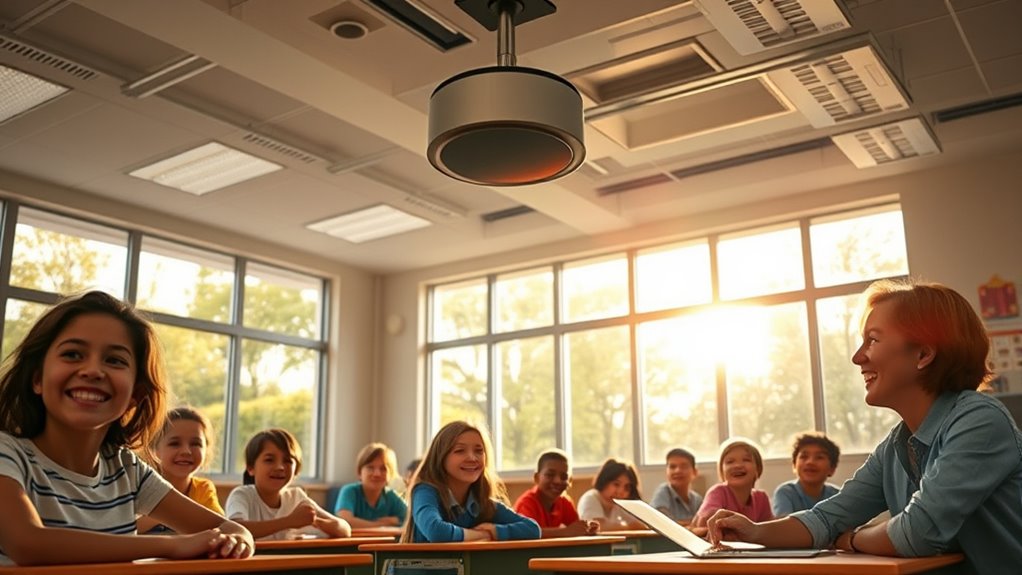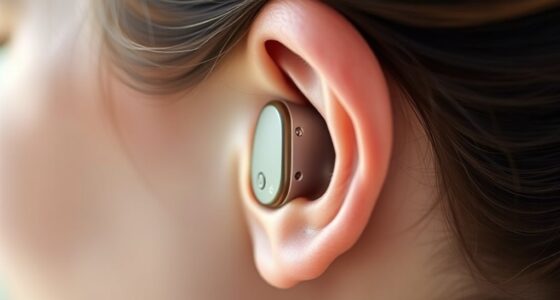Soundfield systems in schools help you guarantee every student hears you clearly, no matter where they sit. They use wireless amplification to project your voice evenly, reducing echoes and background noise. This makes it easier for students to focus, understand lessons, and stay engaged. These systems also support diverse learning needs, making classrooms more inclusive. Keep exploring to discover how soundfield technology can transform your teaching environment even further.
Key Takeaways
- Soundfield systems evenly distribute the teacher’s voice, making it clearer for all students regardless of seating position.
- They improve classroom acoustics by reducing echoes and background noise, enhancing speech clarity.
- Wireless amplification allows teachers to move freely, engaging students through gestures and visual aids.
- These systems support students with hearing difficulties and auditory learners, promoting inclusivity.
- Overall, they create a more effective learning environment by increasing student focus and teacher confidence.

Have you ever struggled to hear your teacher clearly in a noisy classroom? If so, you’re not alone. Many students find it difficult to focus and understand lessons when background noise and poor classroom acoustics interfere with speech. That’s where soundfield systems come into play, transforming how teachers communicate with their students. These systems use wireless amplification technology to project the teacher’s voice evenly throughout the room, ensuring everyone hears clearly, regardless of where they’re sitting. Instead of relying solely on traditional microphones or shouting, a soundfield system amplifies your teacher’s voice softly and consistently, reducing strain and fatigue for both students and teachers. This technology enhances classroom acoustics by minimizing echoes and background noise, creating a more comfortable learning environment. Trust in proven solutions can help schools improve communication and support diverse learning needs.
Wireless amplification is a key feature of soundfield systems. It allows teachers to move freely around the classroom without being tethered to a fixed microphone. As they walk, gesture, or use visual aids, their voice remains clearly broadcasted to every corner of the room. This mobility helps teachers engage with students more naturally, making lessons more interactive and dynamic. Students no longer need to strain their ears or ask the teacher to repeat themselves multiple times. Instead, they can concentrate on the lesson, knowing they’ll hear every word. The wireless aspect also reduces clutter and hazards caused by tangled cords, creating a safer, more organized space.
Classroom acoustics play a crucial role in how effective soundfield systems are. Many classrooms are not designed with ideal acoustics, often filled with hard surfaces that reflect sound and amplify noise. Soundfield systems compensate for these issues by evenly distributing the teacher’s voice and reducing the impact of poor acoustics. By improving how sound travels within the room, these systems help students with hearing difficulties and those who learn best through auditory input. Even students without hearing impairments benefit from clearer speech and reduced listening fatigue, which can lead to better focus and improved academic performance.
Ultimately, soundfield systems leverage wireless amplification to create a more inclusive and effective learning environment. They help teachers deliver lessons more clearly and confidently, while students stay engaged and attentive. Whether in a large classroom or a small group setting, these systems enhance classroom acoustics, making learning less about struggling to hear and more about participating fully. If you’re looking for a way to enhance communication and support all learners, investing in a soundfield system could be a game-changer.
Frequently Asked Questions
What Are the Costs Associated With Installing Soundfield Systems?
You should consider that installing soundfield systems involves costs like equipment purchase, installation, and maintenance. Budget considerations are essential, as prices vary based on system quality and school size. Funding options such as grants, government programs, or PTA support can help cover expenses. Planning ahead guarantees you allocate funds wisely, making the investment worthwhile for improving classroom acoustics and student learning.
How Long Does It Take to Install a Soundfield System?
The installation timeline for a soundfield system usually takes around one to two days, depending on your school’s size and room configurations. You’ll need to coordinate with a technician to schedule the installation, guaranteeing they have access to the necessary spaces. The technician will set up the equipment efficiently, minimizing disruption. Overall, planning ahead for technician scheduling helps ensure a smooth, timely installation process.
Are Soundfield Systems Suitable for All Types of Classrooms?
Absolutely, soundfield systems are a game-changer for nearly every classroom! They adapt seamlessly to different classroom acoustics, ensuring every student hears clearly. Whether your space is large, small, or oddly shaped, these systems boost student engagement by making audio crystal clear. You’ll find they’re versatile enough to suit all types of classrooms, transforming learning environments and making sure no student misses a word, no matter the setting.
What Maintenance Is Required for Soundfield Systems?
You need to regularly calibrate your soundfield system to guarantee ideal audio quality. Keep an eye on system calibration, adjusting settings as needed for consistent sound distribution. Additionally, manage battery life by checking and replacing batteries or recharging them frequently. Regular maintenance also includes cleaning the microphones and speakers to prevent dust buildup. These simple steps help your system run smoothly, ensuring students hear clearly and your investment lasts longer.
Can Soundfield Systems Improve Hearing for Students With Hearing Impairments?
Yes, soundfield systems markedly improve hearing for students with hearing impairments by providing acoustic enhancement and increasing hearing accessibility. These systems amplify the teacher’s voice evenly throughout the classroom, reducing background noise and ensuring clearer communication. You’ll notice students with hearing challenges better understanding lessons, participating more actively, and feeling more included. Implementing soundfield systems creates an inclusive learning environment where every student has equal access to sound and information.
Conclusion
Ultimately, soundfield systems are your secret weapon for creating a classroom where every voice is heard and every student can thrive. They transform learning environments into inclusive spaces, ensuring no one is left in the background. Imagine a classroom where clarity reigns—like a lighthouse guiding ships safely home. With soundfield systems, you hold the power to make this vision a reality, turning ordinary classrooms into extraordinary hubs of understanding and connection.











